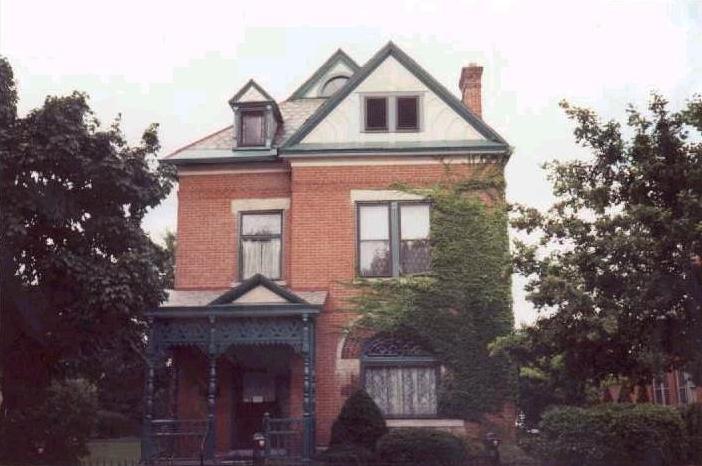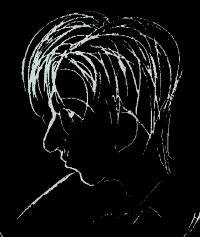



James Thurber lived here from his childhood up through his years at OSU. He was State House reporter for a Columbus newspaper, and later had a lucrative career as a cartoonist and humorist. His stories were collected in My Life and Hard Times, and one of them, "The Secret Life of Walter Mitty," was made into a movie starring Danny Kaye and Boris Karloff. His cartoons and essays are dated but still amusing.
His house qualifies as haunted mainly because of an incident he wrote about in the story "The Night the Ghost Got In." He claimed to have heard footsteps walking around and around downstairs in the kitchen and then running up the stairs. I was never very interested in this until I heard that the history of the Thurber House includes a man who killed himself after pacing around the kitchen table and then running upstairs to blow his brains out. James Thurber himself later wrote about the story behind "The Night the Ghost Got In," describing the times when he and his brother heard the noises and his later investigations. This is Thurber's account of the story behind his story:
"My own experience in this mysterious area came one night, about 1912, in a house my family lived in at 77 Jefferson Avenue in Columbus . . . . It consists of the heavy steps of a man walking for nearly a minute around our dining room table, while I was in the bathroom upstairs drying my face with a towel before going to bed. At the time I was a junior at college, studying journalism, and a non-believer in ghosts. In fact, the word ghost never crossed my mind that night. I thought a burglar or crazy man had got into the house. My father and younger brother were in Indianapolis and I knew that neither of them would talk silently around that table. I roused my older brother from sleep and brought him to the head of the back stairs that went down into the dining room. As soon as he reached my side, the steps ceased. Finally, in something like terror, he asked me, 'What's the matter with you?'
"I said, in a loud voice, 'There's someone down there,' and up the stairs, right at us, two at a time, came the heavy steps of a running man. Without a word, my brother ran into his bedroom and locked the door. I stood there until one more step would have brought the invisible thing into me and then, by a reflex, I slammed the door at the head of the steps. The next day I asked the corner druggist, who had been in business there for thirty years, if he had ever heard any strange stories about 77 Jefferson Avenue. He said, in surprise, 'Didn't you know about the steps that go around the dining room table and run up the stairs?' I then began a long research on the business, even slept downstairs several nights alone, at the proper hour on the proper night of the week, but never heard the steps again. It turned out that several families had previously moved out of the house because of the steps. I turned this into a comic story called 'The Night the Ghost Got In' nearly thirty years ago, but now I am telling it factually. . . .
"My careful researches, more than forty-five years ago, revealed the story of a man who had lived in that house, had walked around the dining room table, then ran up the stairs and shot himself in one of the second floor rooms. He left a note describing his final behavior, but it was destroyed by the family. I found out, and the police have never heard of it, and I promised I would not tell about the note. . . . A strange voice, anonymous, had telephoned him at his office one morning and told him that if he went home around ten A.M., entered the kitchen door, and stood quietly in the dining room, he would hear his wife making her daily assignation with her lover and this is precisely what happened."
Thurber's research gives us a rare glimpse into the details of an apparently true ghost story. The ghost at his house was a suicide, driven to blow his brains out by his cheating wife. Incidentally, the actual date of Thurber's encounter with the ghost was November 17, 1915--exactly forty-seven years to the day after the Ohio Lunatic Asylum, which stood where the house now stands, burned to the ground, killing seven people.
After Thurber's family moved out, a woman bought the house and started renting rooms. One of the renters recalled that the woman asked one of her boarders to stay with her each weekend evening. The reason? Ghostly footsteps running up the back steps.
After that the Thurber House stood empty for years, before being renovated and turned into a literary tourist attraction. Today the third floor is often home to a writer-in-residence, and the lower floors are open for self-guided tours. Over the years, the writers-in-residence have encountered the ghost a time or two.
As one said,
"In my second or third week at the house, as I stepped out of a car in the back parking lot, I happened to look up to the apartment and the ghost--a hefty, somewhat stooped, black torso shadow, apparently dressed in a raincoat with the collar turned up, moving at a silhouette's pace--made a single pass through the hallway lights just as my eyes travelled up the building wall, as if waiting there, set in motion by a glance.
"I took the sighting seriously. I even made Donna Vickers walk me upstairs, but when we got to the spot, only the spot was there.
"Later in my stay, I heard unaccountable clattering of the lower kitchen cupboards, light gentle fast frustrated slamming, as if a mouse were inside trying to push out with its nose, but there was no mouse when I looked."
Another writer was awakened in the middle of the night by the burglar alarm, which had gone off mysteriously even though all the doors and windows were locked from the inside. A third wrote an essay about her stay at the Thurber House.
"I have to start this story the way I always do: by telling you right up front that I do not believe in ghosts. That said, this is a story about how I lived for a summer in the attic of a haunted house. . . I don't believe in ghosts, but I do believe in inexplicable occurrences, and surely the things that happened to me (and my dog) the summer of 1994 in Columbus, Ohio, can't all be explained away.
"[The ghost] stories were entertaining, but they had a nasty way of coming back to me late at night. . . .
"During the day, the house is busy; phones ring, staff members chat and visitors pop in and out of the rooms, plunking the keys of the typewriter Thurber used at the New Yorker and staring at the photos on the walls. But at 5 P.M., the house empties. The other buildings along the street also close, and after dark Toby and I were the only living souls on the entire block.
"And it was usually after dark when I, too, heard footsteps, treading one floor below. . . . Sooner or later, whoever lived there heard footsteps. . . .
"Every night, when I shut off the lights and crawled into bed, I left on the air-conditioner so I wouldn't have to hear them, but I heard them quite often anyway. At first it was only occasionally, but for a stretch of about two weeks in July I heard them every night, walking briskly up and down the hallway one floor below.
"One night I leashed up the dog and crept down the attic stairs to see if we could find the source of the noise. We peeked into the silent bedrooms and the cool white bathroom and then, spooked by nothing more than the darkness, dashed back upstairs to the apartment, where I had left all the lights burning and the TV blaring, and slammed the door.
"Toward the end of summer, Toby saw the ghost downstairs.
"It was evening, and the house had been shut up for the night--the shades drawn, the lights turned off, the doors securely locked. The was my favorite time to prowl the museum. As long as some late-afternoon light filtered in from outside, the hosue seemed friendlier at this quiet time of day.
"I wandered into the museum bookstore, and Toby meandered down the hall. And then, just as before, I heard him growl.
"He was two rooms away, in the museum's front parlor, staring at a velvet couch beneath a leaded-glass window. The evening sun was setting, and the sky outside was a dark pink and gold.
"Just as before, Toby's body was tense. And just as before, he growled, though this time with more certainty.
"I tried to walk past him to see what was alarming him, but Toby wouldn't allow it. He moved in front of me, blocking my way, keeping me from the couch and whatever invisible thing was on it.
"It was a full minute, I think, before he stopped. His snarls trailed into silence, and then he walked hesitantly to the couch and sniffed it all over in puzzlement.
"It was as though whatever had been there had disappeared.
"I haven't come to any great conclusions about what happened in that house that summer. I talk about it pretty freely, but whenever I do I always preface my story with the statement, 'I don't believe in ghosts,' before going on to mention the ways I experienced the ghost. Somehow, that doesn't feel like a contradiction."
The Thurber House may be the most haunted house in Columbus. I've been there, but I was merely a tourist. I'd kill to spend the night in the place.
Unfortunately, this is one of those stories that's often used more for humor than anything else, and the ghost has probably been scared away by generations of Mrs. Harvey's eleventh grade English students. The house itself is pretty interesting, though, and the people who staff it are very friendly. I asked them if they'd ever seen the ghost and they said no; I'm sure they get asked all the time. The weirdest thing about the place is the resident author who lives upstairs in the attic. It's located at 77 Jefferson Avenue, phone (614) 464-1032. Or visit their website at thurberhouse.org.

Smith, Robin. Columbus Ghosts. Worthington, OH: Emuses, Inc., 2002. pp. 35-40.